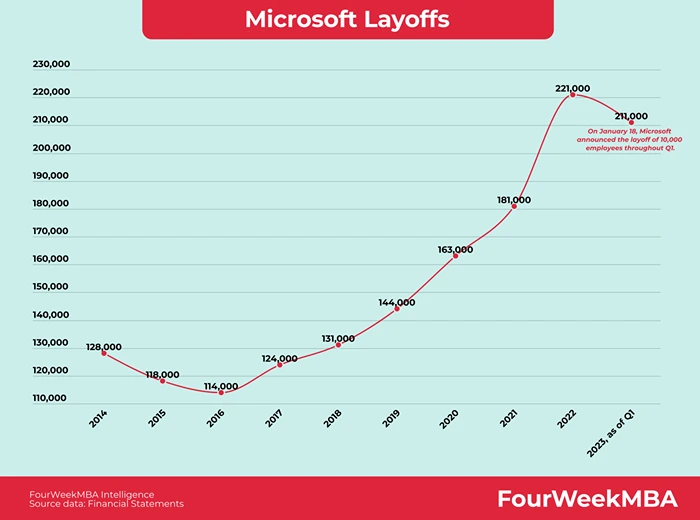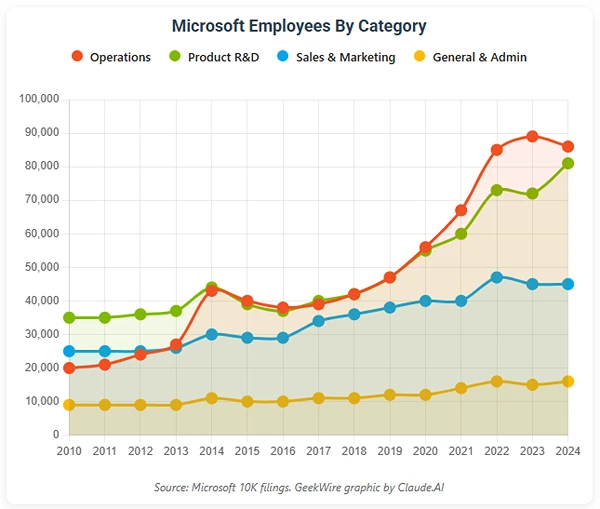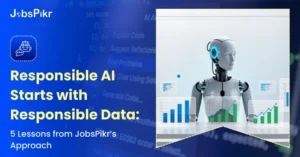- The Profitable Layoff Paradox
- The Wider Context: AI as Catalyst for Restructuring
- What Matters: Information and Data Sources
- The Eight Early-Warning Signals
- Timeline Analysis: How Over Time the Signals Built Up
- Geographic Intelligence: A Map for Talent Reallocation
- Role Evolution: The Skills Transformation Matrix
- Hiring Velocity: Fast-Track vs. Stalled Pipeline
- Posting Intelligence is the New Competitive Advantage
- FAQs
Every Company has a story to tell in their public postings and their shifts in hiring can speak volumes. In this case let’s take into consideration Microsoft and how their public job postings hinted at their 2025 workforce change. Even further, let’s delve into the lessons we can take from it.
The Profitable Layoff Paradox
In 2025, Microsoft made headlines with a significant reduction in headcount, slashing more than 15,000 jobs, roughly 7% of its global workforce. This, for many, was a shocking and bewildering piece of news. How could such a well performing company incur such a colossal cut, performing net income of $27.2 billion (up 24% YoY) and investing in AI $80 billion annually?
This was not a company in distress. This was a company in transformation. The Microsoft layoffs were not signs of contraction. Microsoft was attempting a controlled and careful transformation of its very DNA. The signs of Microsoft’s shift were not striking headlines, they were in the form of job postings. Microsoft’s own careers page reflected the shift hours. Through tracking public postings over time, one could monitor the change in real time for months. The surge in AI positions replacing traditional software roles was more than pronounced. Entire departments shifted their hiring direction or changed the regions they were expanding to. Such job data, when interpreted with caution, illuminate a company’s direction long before official announcements are made.
Microsoft’s attention to pivots in hiring trends exemplifies the shifts in the industry, including the newest one in 2025, illustrating the advantages it holds for professionals seeking to make better career or business choices.
Key signals tracking the shifts in industry came as (Also see Tech-Sector Employment Signals):
- AI/ML job openings posted in comparison to the previous year showed a significant surge; corroborating the Role Mix Shift.
- An apparent slowdown at the company’s headquarters where a majority of traditional postings paused or were prior to removal.
- Non AI job postings remained stale for a duration of 30 or more days, while AI job postings were refreshed in under a week.
- For some reasons, officially announcing layoffs appeared to be the least of company concerns as signals emerged 3-6 months prior.
If you are strategizing and thinking about planning a workforce, or if you are focused on developing your career, these trends are worth looking into. Most companies offer these opportunities but delay capitalizing on them.

Source: https://fourweekmba.com/microsoft-layoffs/
The Wider Context: AI as Catalyst for Restructuring
How does a corporation with record profits and growth resort to slashing thousands of jobs? This paradox is most clearly evident for Microsoft, and it reflects broader trends in the U.S. Labor Market 2025.
The company’s 2025 cuts exemplified what for Microsoft was a new period of not just a contraction, but an acceleration, which was the refocusing of the company’s direction as an AI-first enterprise. It was a decade of enterprise evolution.
- Microsoft’s financial prowess stood strong as always.
- Microsoft’s income soared to $27.2 billion in Q4 2024.
- Cloud earnings from Azure surged 31% compared to the previous year.
- Expenditures on AI grew to over $80 billion yearly for new data centers, GPUs, and other infrastructure.
The numbers clarify the problem. It is apparent that Microsoft’s strategy shifted from maintaining operational expenditures, in this case, salary, to investing in AI infrastructure. The layoffs were not an indication of financial stress. Instead, these were strategically timed to improve the company’s operational design, a transformation targeted on AI and value creation.
Methodology: Analyzing Job Posting Analytics
Shifts in corporate strategy do not appear out of thin air. With the right foresight, the public unveiling of job postings in itself is a major indicator of a company’s shifting landscape. A company’s job postings illustrate evolving business priorities, and when viewed over time, postings reveal both the strategic direction of the company and its evolving talent requirements.
What Matters: Information and Data Sources
Microsoft Careers Portal: A window into the company’s shifting priorities and serves as a precise indicator of the company’s hiring activities. Roles that were being filled and the corresponding teams are indicative of keen hiring intent.
Job Aggregators (LinkedIn, Indeed, Glassdoor, etc.): These platforms contribute towards broader market movement. They enhance the ability to recognize shifting momentum and widespread patterns across regions and industries.
WARN Filings: Legally mandated for large-scale layoffs in the U.S., these filings offer precise timestamps connecting job posting sequences to actual workforce reductions.
Media Coverage (Bloomberg, CNBC, etc.): Reliably covering business happenings, media outlets corroborate events and offer visibility that job data lacks. Although not primary data, media coverage serves as confirmation of events observable through job data.
Interpreting the Data
It is possible to monitor both the volume and associated dynamics of postings:
- Temporal Tracking: Watching for the addition and modification of postings as they come in and out to understand the hiring patterns of the business.
- Semantic Analysis: Assessing which words (“Copilot,” “LLM,” “GPU,” “efficiency,” “automation”) were used and were of consideration during that period and so reflected the business focus.
- Geographic Mapping: Establishing the cities and countries that were gaining or losing roles and hence reflecting the changing strategy in terms of where to source for talent.
- Role Classification: Tracking the ratio of “AI” and “non-AI” jobs to monitor the change in the composition of talent.
- Hiring Velocity: Monitoring the age of a vacancy to assess the pace of a company’s activity to fill it. This is a strong measure of the importance of the position to the company.
The Eight Early-Warning Signals
The data revealed a primary subset of eight such predictive patterns. Observing a number of them in combination would greatly heighten confidence in anticipation of a significant change. This preemptive change would be observed far in advance of any formal communications.
- Posting Volume Drop: Observed in the non-AI roles. This is often the first signal. Using this approach, one could note greater than 25% reduction in the addition of non AI roles several months prior to the reductions.
- Job Age Extension: An open position for more than a month within a tight labor market signals stagnation in the hiring funnel. This approach might have indicated that 45% of non-AI roles at Microsoft had an ‘age’ of over 30 days, which could suggest a subtle precursor to the Microsoft layoffs of 2025.
- AI-Keyword Spike: Job descriptions began to incorporate terms “LLM,” “Copilot,” “GPU,” and “automation” to a previously unnoticed degree. In the period between Q3 2024 and Q1 2025, the proportion of posts containing these phrases surged from 15% to almost 67%.
- Location Consolidation: Job ads evolved from “multiple locations” to being tied to specific hubs. This indicates a shift to a more centralized talent strategy that focuses on operational efficiency and cost containment. Also, it shows a shift from a more distributed model to a centralized, optimized approach. There was a 60% reduction in “multiple locations” postings before the cuts.
- Requirements Inflation: 2-3 years of experience is now required for an entry level position. This is a clear reduction in a company’s investment in training. This trend was first noticed 3-4 months before the layoffs were made public.
- Shifts in Language in Relation to Job Ads: Microsoft started using words like “redeployment,” “optimization,” and “efficiency” more frequently.
- Pre-Announcements of Removals: The most straightforward indicator. In a hypothetical situation, a mass removal could consist of over 1,200 ads vanishing within a very short period, which would occur just prior to a WARN announcement or earnings call.
- Intern Drought: The marked disappearance or sharp decline of intern and junior level positions. Indicates a more concerning decline in strategy where a firm stops planning for future talent. The strategy would most likely justify an observed 78% decline in these advertisements prior to the reductions, which would indicate a hiring freeze for junior positions.
Timeline Analysis: How Over Time the Signals Built Up
Microsoft’s 2025 restructuring came as a shock, but a closer look at the shifts in the hiring landscape reveals a more complex, multi-faceted story.
Phase 1: Preliminary clues (Late 2024)
The earliest clues were not focused on a reduction in staffing levels but rather the type of roles being offered. The AI and Machine Learning positions surged well ahead of the traditional software roles which were on the back burner. “Copilot,” “LLM,” and “GPU infrastructure” roles became ubiquitous in the major global recruiting centers of Bangalore, Dublin, and Tel Aviv. At the same time, conventional software engineering roles experienced a 25% decline.
Phase 2: Performance-Based Reduction (January 2025)
The beginning of 2025 came with augmented realities, as reflected by the job board. Intern and entry level positions shrank by 78% and junior positions were described 2-3 years more experienced. Several non AI positions were short termed and posted as contracts, indicating a more situational and tactical approach. Traditional software roles underwent a 50% decline in just one quarter.
Phase 3: Global Restructuring (May 2025)
Microsoft’s WARN filings in May triggered a series of events that, in retrospect, served as unignorable indicators. In an illustrative model, bulk removal of listings—positions vanishing over a short time period—might be observed during the months that preceded Microsoft’s May WARN filings. At the same time, the “multiple locations” postings were downscaled by 60%, with a significant fraction of remaining positions being labeled as ‘hybrid’ or ‘remote.’ This suggests a concerted effort towards global talent hubs. This came to a head with the public declaration of 1,985 positions being eliminated in Washington State, which directly aligned with the preceding posting patterns. This round of cuts marked one of the most significant shifts in workforce restructuring that Microsoft had undertaken to date.

Source: World Economic Forum
Phase 4: Division-Specific Culling (June to July 2025)
The remainder of the summer saw a greater focus on precision. For example, the Xbox division’s job listings nosedived, with a decrease of nearly 90% compared to the listing activity earlier in the year. Additionally, the more traditional sales roles began to disappear, giving way to positions designated as “AI Sales Solutions.” This change showcased the degree to which automation was overtaking even the more client-facing roles. The information corroborated the theory that the reductions were not merely blanket company-wide cuts, but rather targeted in a strategically deliberate manner to areas whose functions were being automated or replaced with AI technologies. For a similar deep-dive on another major round of cuts, see our Starbucks Corporate Layoffs analysis.
Geographic Intelligence: A Map for Talent Reallocation
Microsoft exhibits an AI-powered transformation and a geographic strategy at the same time. AI innovation no longer treated Microsoft as a single, unified, and monolithic structure; the company was instead a distributed network of specialized hubs.
Headquarters Reduction Redmond, Washington ceased to be a multifunctional engineering center. From March 2024 to August 2025, Redmond experienced over 60% reduction in old job roles. Illustrative data showed the AI infrastructure positions, however, surpassing pre-2024 levels, transforming Redmond to an AI innovation core. Many of the remaining non-AI roles were contracted, with 66% of new non-AI positions being contracts instead of full-time positions.
Where is Microsoft building its future? The hiring data illustrates at least a few core international hubs to look for.
- Bangalore, India: One of the regions to receive a lot of new AI and cloud positions, in addition to a $3B investment in talent and infrastructure.
- Hyderabad, India: Considerable improvement in the hiring of customer support and technical solutions was noted here, in line with Microsoft’s strategy of scaling support at lower cost.
- Shenzhen, China and Riyadh, Saudi Arabia: The expansion of capabilities in these areas, together with new multi-billion-dollar funding, was likely the cause of the spike in AI and hardware positions.
- Austin, Atlanta, and Huntsville (US): These cities have become important centers for AI, cloud technology, and government contracts. The development appears to reflect an avoidance strategy for talent markets such as Silicon Valley, which is known to be expensive.
Note: These trends, as noted in public postings, are directional and do not reflect an exhaustive count. For a broader look at hiring patterns worldwide, see Global Job Market Data & Insights.
Role Evolution: The Skills Transformation Matrix
Microsoft layoffs are an example of a workforce product that has evolved and been streamlined in order to meet newly defined demands. Tracking which roles grew and which roles shrunk enables us to chart out this skills transformation.
These roles form the nucleus of Microsoft’s strategic repositioning, commanding premium pay and acceleration in headcount additions.
- AI/ML Engineers: AI/ML engineer roles, accompanied by a compensation of $140K to $280K, bear a strong appetite for hands-on experience with tools such as PyTorch, TensorFlow and MLOps frameworks.
- AI Data Scientists: Having a prompt engineer work with advanced systems such as Copilot and GPT-4 is standard with AI Data Scientists, who typically earn between $130K and $250K.
- AI Platform Engineers: Azure AI, Kubernetes and GPU cluster skills commanding $160K-$310K are also in demand.

Source: GeekWire
The Fade of Traditional Roles: These roles are defined by their lean to obsolescence as a result of AI tools automating previously necessary functions. An example would include seeing first-job opportunities vanish completely by over 75% or seeing QA positions shrink by 66%.
- Sales Development Representative: AI powered prospecting tools have completely automated this job function.
- Traditional QA Testing: Replaced with AI-driven test automation frameworks.
- Technical Writing: More and more this work is being automated by generative AI tools.
There was also a marked increase in demand with the skills of Prompt Engineer, MLOps, and working with Large Language Models seeing more than 200% increased demand.
Hiring Velocity: Fast-Track vs. Stalled Pipeline
What gaps a company fills, and in what roles, is a matter of pillar importance. Microsoft’s hiring process offers a striking example of bifurcated hiring. For certain legacy positions, a kind of hiring freeze was in place.
AI Roles: Fast-track hiring. Previously, the pace of AI and cloud role hiring was astonishing. These positions would often take roughly three to four weeks to fill, a stark contrast to the 42-day industry benchmark. Positions were in constant rotation, refreshed every 5 to 7 days, which coupled with accelerated streams of interviews, showed great organizational response urgency to fill critical roles.
Traditional Roles: The Stalled Pipeline Non-AI employment opportunities, on the other hand, seemed to freeze for several months, often extending to 30 to 45 days or more without any progress or updates. Furthermore, these positions often had elongated interview processes that frequently remained unfinished. The “stalled pipeline” is an impactful indicator of an impending workforce reduction, as companies that do not actively hire for positions are likely contemplating the elimination of these roles. This is a typical situation in the labor market that precedes a significant shift.
Posting Intelligence is the New Competitive Advantage
Microsoft’s 2025 shift showcases that the most telling indicators of transformative events often do not lie in the press releases, but instead on the career pages of the companies bearing the changes and waiting to be discovered. This serves as a powerful lesson on competitive intelligence and the offer market not only for professionals and leaders, but analysts as well.
If you’re in Talent Acquisition:
Job postings offer a glimpse into more than just vacant positions. Skill cycles can be monitored in real-time, allowing for a precise tracking and forward-planning for the workforce pipeline. Hiring and demand expectations can be proactively addressed well in advance to market trends.
For Career Professionals:
As an example, consider how a growing company might offer a larger office or additional funding to a contractor who manages the firm’s IT services, just to keep their company’s growth rolling. In contrast, an “Expanding Corporation Seeking Rapid Growth” operates more geared towards their services, successfully holding on to their existing clients while attracting more. These subtle cues could either serve to inform or mislead professionals about a firm’s potential as an industry leader.
For Business Leaders:
As a business leader, it is essential to recognize that analyzing a company’s career page, is an activity which should be done in parallel with the rest of their strategic objectives. A company’s career page can provide insights watchers look to get from an earnings call. Strategic workforce objectives as the name implies is about delivering business impact by design. Consider information from outside the organization to confirm strategic assumptions as business intelligence.
In an age marked by workforce volatility, dynamically influenced by technological shifts, the public careers page is a calm sea amidst the storm. To understand how global talent shortages are reshaping strategy, check out our Global Labor Shortage Trends 2025 report.
Curious how you can track early signals in your own industry?
JobsPikr offers live job market data and talent intelligence, used by analysts, strategists, and workforce planners worldwide. Explore the platform to see what’s possible.
FAQs
1. Why did Microsoft fire 15000 employees?
Microsoft’s decision to cut 15,000 employees in 2025 was led by strategy. The company was reallocating resources away from traditional roles toward automation, AI, and infrastructure. Public job postings highlighted this paradigm shift, revealing a decline in legacy hiring offset by near-exponential growth in AI-related positions.
2. Will there be more layoffs in 2025?
It is difficult to speculate on the actions of a specific company, but observing trends leads to the expected outcome of a greater adjustment in the workforce for the entire tech sector. Changes in hiring tend to signal reorganization, including a thousand-plus days without hiring, a rise in contractual work, and a boom in mid-level and senior positions. Job postings serve as an invaluable early-warning system for outplacement.
3. What job will AI replace?
Jobs with monotonous processes will be the first to be replaced or transformed by AI. Sales development representatives, junior QA testers, and technical writing positions underwent transformations with the introduction of AI at Microsoft. These jobs are being replaced by utilitarian software, automated testing systems, and generative AI. This type of automation does not result in a net job loss; instead, it changes the nature of work with an AI skillset newly in demand.
4. Which job will see the biggest increase of demand by 2025?
Roles AI-related lead to the front of the line. Microsoft’s hiring statistics show increase in the use and demand for AI/ML Engineers and AI Platform Architects, and Data Scientists adept with PyTorch, Azure AI, Kubernetes, and GPU infrastructure. These roles not only experienced an increase in demand, and hiring speed, but were also associated with the largest increases in offered salary.




